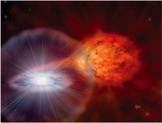

External links |
MINBAR /
Burst AnalysisHere we describe the analysis procedures for the bursts incorporated into the sample. BeppoSAX Wide Field CameraThe burst search was carried out as follows. We estimate the average flux and the standard deviation ($ \sigma $) for each orbit (about 60~min of net exposure time). If a bin is at least 4$ \sigma $ above the average flux we mark this as a candidate burst. We estimate that we have, on average, only one false peak triggered as a burst per observation. A triggered bin is visually approved as a burst if the shape of the lightcurve around the bin can be described by a fast rise and exponential decay. If needed, this is done at 1 s time resolution. Thus, we detect all bursts with e-folding times $ \gtrsim2 $~s and peak fluxes in excess of 0.5~Crab. The WFCs detected 2202 type-I X-ray bursts from 54 LMXBs. The most prolific bursters in this data set are GX 354-0 (439 bursts), KS 1731-26 (343) and GS 1826-24 (271). The time-resolved spectroscopy was carried out as follows.
Fluences were calculated by integrating all flux measurements up to the last spectroscopic point, supplemented with an estimate of the fluence beyond that point as extrapolated by the exponential fit to the light curve of the complete bandpass. For every observation the persistent spectrum as extracted in point 3 was modeled with a power law and thermal bremsstrahlung. Absorption was included, fixing $ N_{\rm H} $ to the literature value. Those fit results are included in the database that yielded the best fit, including the 3-25 keV flux and $ \chi^2_\nu $. Jean in 't Zand 30.4.2011 RXTE Proportional Counter ArrayWhere not explicitly stated, the data analysis procedures are as in Galloway et al. (2008). For those bursts for which suitable datamodes were available, time-resolved spectra in the range 2--60~keV covering the burst duration were extracted on intervals beginnng at 0.25 s during the burst rise and peak. The bin size was gradually increased into the burst tail to maintain roughly the same signal-to-noise level. A spectrum taken from a 16-s interval prior to the burst was adopted as the background. % The {\it RXTE}\/ Proportional Counter Units (PCUs) are subject to a short ($ \approx 10\ \mu $s) interval of inactivity following the detection of each X-ray photon. This ``deadtime'' reduces the detected count rate below what is incident on the detector (by approximately 3\% for an incident rate of 400~count~s$ ^{−1} $~PCU$ ^{−1} $). We corrected each spectrum for deadtime by calculating an effective exposure, depending upon the measured count rate, which takes into account the deadtime fraction. We re-fit the spectra over the energy range 2.5--20~keV using the revised PCA response matrices, v11.7\footnote{see \url{ http://www.universe.nasa.gov/xrays/programs/rxte/pca/doc/rmf/pcarmf-11.7 } } and adopted the recommended systematic error of 0.5\%. The fitting was undertaken using {\sc XSpec } version 12. In order to accommodate spectral bins with low count rates, we adopted Churazov weighting. % We modelled the effects of interstellar absorption, using a multiplicative model component ({\tt wabs } in {\sc XSpec}), with the column density $ n_{\rm H} $ frozen at insert details here. In the original analysis carried out by \cite{bcatalog}, the neutral absorption was determined separately for each burst, from the mean value obtained for spectral fits carried out with the $ n_{\rm H} $ value free to vary. This has a negligible effect on the burst flux, but can introduce spurious burst-to-burst variations in the blackbody normalisation. Duncan Galloway 24.9.2014 INTEGRAL Joint European X-Ray Monitor |